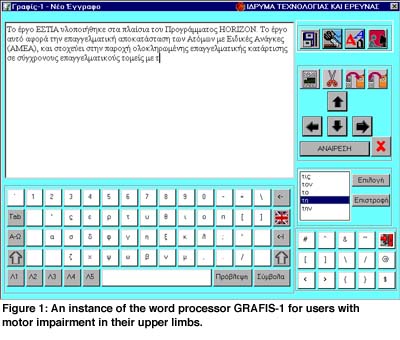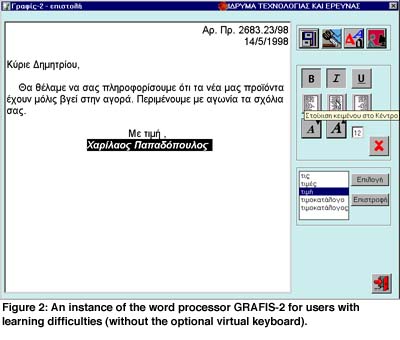The GRAFIS Word Processor for People with Disabilities
by Constantine Stephanidis
GRAFIS is a word processor specifically developed for disabled
people at ICS-FORTH in the framework of the HORIZON ESTIA Project.
This project ran from January 1996 to June 1998 and focused on
the vocational training of unemployed disabled people, through
the use of information technologies.
GRAFIS supports the typical word processing functionality, through
a simple interface, accessible through conventional as well as
alternative input-output devices. The basic characteristics of
the interface are: (a) a clear separation between the ‘text-input’
and ‘function’ areas, and (b) elimination of overlapping objects
on the screen through the grouping of functions in alternative
function areas.
In addition to text input (in Greek and English), manipulation
and formatting, GRAFIS features a simplified interface for storing,
retrieving and otherwise managing document files. The user is
supported by an extensive on-line help system which describes
the interface and guides the user in the completion of common
word processing tasks. GRAFIS also supports saving and loading
documents in Rich-Text Format (RTF), thus allowing users to share
and exchange documents with their able-bodied counterparts employing
mainstream word processors.
GRAFIS supports a variety of input devices, including conventional
and special keyboards, mouse, trackball, mouse emulators and binary
switches. Interaction through switches is made possible through
the use of interaction scanning techniques developed at ICS-FORTH.
These techniques allow users that can operate only a single binary
switch to make full use of the word processor.
Text input for users employing binary switches is supported through
virtual keyboards with alternative key arrangements, namely: (a)
QWERTY, and (b) letter-frequency based (ie, keys are arranged
based on the frequency of letters and digraphs in each of the
supported languages). Rate enhancement is also achieved by means
of a word prediction function, which performs context-based prediction
of the possible next words in a text, or of the continuation of
the word currently being typed. Word prediction is based on a
simple statistical technique applied to exemplary documents (eg,
general-case business letters), prior to the use of GRAFIS, or
documents that the user has edited, once a significant corpus
of typical cases of such documents exists.
One of the primary design objectives of GRAFIS concerned the ease
of customisation of the interface by both facilitators and end
users. Customisable characteristics include colour (background,
virtual keyboards, etc.), dimension of characters in the virtual
keyboard, activation / deactivation of acoustic feedback, and
interaction scanning attributes (eg, speed).
GRAFIS addresses two main categories of disability, for which
there exist separate versions of the word processor: GRAFIS–1
for users with motor impairment in upper limbs and GRAFIS–2 for
users with learning difficulties. Both versions support the previously
described functionality in its entirety, and have very similar
interfaces, but differ in terms of the input techniques; the latter
are provided on the basis of user characteristics and requirements.
For instance, GRAFIS-1 supports virtual keyboards and scanning
for access through mouse and binary switches, while GRAFIS-2 supports
input through conventional keyboard and mouse, and offers the
virtual keyboard optionally. Figure 1 depicts an instance of GRAFIS–1,
and Figure 2 an instance of GRAFIS–2.


Both versions of the GRAFIS word processor have been tested and
evaluated by end-users during the vocational training and pilot
employment phases of the ESTIA project. Additionally, after the
completion of the ESTIA project, GRAFIS was distributed to selected
disability organisations and end users for further evaluation.
The results of the various evaluation phases have shown that GRAFIS
is easy to learn and use, and that its characteristics are appreciated,
in particular by users with no previous experience in word processing.
Partners in the HORIZON ESTIA Project were: ICS-FORTH, University
of Athens Department of Informatics, Idrima Kinonikis Ergasias,
Panellinios Sindesmos Tiflon, Idrima Pammakaristos, Eteria Spastikon
Voriou Ellados, Euroskills, INESC-Portugal.
Please contact:
Constantine Stephanidis - ICS-FORTH
Tel: +30 81 39 17 41
E-mail: cs@ics.forth.gr
